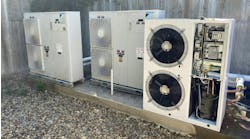OFTENTIMES WHEN WE, as hydronic heating contractors, get the opportunity to supply and install a companion domestic hot water heating system, our responsibility stops at the hydronic connections. The plumber on the job has the task of making the hot and cold potable water connections to the storage tank.
I guess there has to be a demarcation of responsibility somewhere along these lines unless you are the heating and plumbing contractor. If this is not the case, however, if and when a problem occurs with the DHW system, the plumber always claims mechanical immunity because the “heating guy” supplied the DHW unit. So, the homeowner does the most logical thing ¯ he calls you, the heating guy, to fix his domestic hot water problem.
Jeez, if I’d have known that I was going to be responsible for the plumber’s work too, I’d have charged more money so I could cover his warranty calls. It’s too late to worry about that, and as far as the consumer is concerned, it’s your problem now after all, isn’t it?
You can address this contractually in a couple of ways. You can clearly spell out in your contract that you are responsible only for the “supply” of DHW, and not necessarily its distribution. This alleviates you of any field distribution problems, but the job of proving that it’s a “distribution problem” and not a “source problem” still lies with you.
Another approach is for you to alleviate many distribution problems by moving the demarcation line to the DHW storage tank’s potable isolation valves, which you provide. This makes you wholly responsible for the heat source and the near-tank circulation return piping, which can eliminate some, but not all distribution problems.
If the plumber is adamant about doing the connections on the potable side of the tank, agree with him with this stipulation. Tell him that inasmuch as you, the heating guy, are responsible for the DHW supply, you want him to pipe the circulation return the way you want it to be, and then you’ll take responsibility for its correct operation. That usually quells any potential complaints from the plumber.
You then provide him with the drawing to the right that shows how you want the circulation return pump piped, and everyone goes his own merry way. Until, that is, the homeowner calls and complains that the water in his shower is not hot enough.
Again, the plumber asserts mechanical immunity, as spelled out by his contract with the general contractor, and you find yourself standing in the homeowner’s less than comfortable shower, trying to figure out the workings of an anti-scald shower valve that was never properly adjusted after installation.
You could have easily thrown the ball back into the plumber’s court by installing a thermometer at the tank outlet and instructing the homeowner that if he sees a high temperature at the tank outlet, then any problems he has downstream from that point are not your problem. But then that probably wouldn’t be the politically correct way of handling the problem. I’d still suggest a tank outlet thermometer.
In any case, all problems associated with the DHW system have now become your problem, and the following list pertains to common problems and their cures. While it is virtually impossible to cover everything, these will at least get you headed in the right direction to resolution and a happy customer.
The one we’ll cover this month is the “fluctuating shower hot water syndrome.” This one generally shows up at the shower that is the farthest away from the storage tank. That is technically the end of the domestic hot water distribution system and the beginning of the DHW circulation return line, which is supposed to keep hot water instantaneously available throughout the house. If there is no check valve on the return line down at the circulator, however, and the path of least resistance between the hot water line and the circulation return line are approximately the same, cold water charges backwards up the circulation return line to the shower valve and mixes with the hot water coming from the other direction.
This causes the shower user to adjust the valve to a hotter position. The water get a little hotter for a while, until more cold water works its way back up the circulation return line and continues to dilute the hot water feeding into the valve. If the circulation return pump happens to turn on while all of this is going on, the user gets hit with a blast of hot water. If you are unlucky, the user jumps out of the shower, gets his leg caught between the toilet and the bathtub, then tips over, breaking his leg and suing you into non-existence (true story).
The solution to this one is quite simple. Make sure there is a check valve (preferably a spring check) in the circulation return line down near the circulator to avoid the possibility of cold water feeding backwards through the circulation return line. Don’t bother putting one on the cold water inlet line unless you have concerns about the hot water backing into the cold water main due to thermal expansion. And, if that is a concern, make darn sure to install a properly sized potable water thermal expansion tank between the check valve and the storage tank.
Don’t forget to check out the Radiant Panel Association conference and REX in Cincinnati next month. Yours truly will be doing a breakout session on the cost of doing business. Go there to get more information.
Until then, Happy Educated Hydronicing!
Mark Eatherton is a Denver-based hydronics contractor. He can be reached via e-mail at [email protected] or by phone at 303/778-7772.

